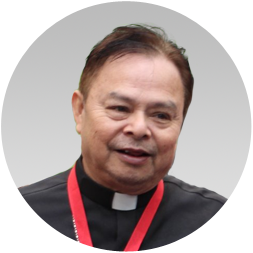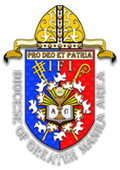SECULARIZATION OF THE
IGLESIA FILIPINA INDEPENDIENTE
(REVISITED)

By: The Rev. Dr. Hermogenes P. Verano
Retired Priest, Diocese of Greater Manila Area
Probably the framers of the IFI Constitution and Canons of 1977 could have knowingly or unknowingly impacted the crucial effect of secularization in the affairs of the Church. When we speak of a secularized Church, we are referring to giving the laity a greater participation in the governance and the administration of the Church as an organization. As the end result of the religious emancipation from the Imperial Roman Catholic Church, the excited delegates of the IFI Constitutional Convention in 1977 could have thought of fusing the principles of democracy in the management of the 117-year old indigenous, nationalist, and independent Church.
SECULARISM DEFINED
In the English-Filipino Dictionary of Philosophy, Dr. Ballena defines secularism as: "pag-uugali, kilos at patakaran na nagbubuklod sa mga bagay na relihiyoso o eklesyastico mula sa mga bagay na sibil, humanista at pangmundo..." In other words, it is a belief that religion's influence should be restricted. Not under the complete control of religion, the temporal, that is relating to earthly life, partly shares with the spiritual, that is relating to the sacred matters, in the administration of the Church. The domain of the laity is temporal while the domain of the priesthood is spiritual. But then is it possible that the spiritual collides with the temporal and vice- versa? The religion is after the faithful obedience, reverence, and spiritual worship of the Creator; while the laity is after its temporal existence now on earth. Ah, complicated!
ORIGINAL IDEA
According to history, when Msgr. Gregorio Aglipay, the first Obispo Maximo or Supreme Bishop of the once fledgling IFI aspired for the highest political position in our country, he could have thought that if he became successful in his attempt in landing in a government position, the IFI would gradually become the national church like the Anglican Church of England (Great Britain) which is sustained by the state. The Church of England absolutely severed relations with the Roman Catholic Church. This perhaps was the original purpose of the Venerable Msgr. Aglipay; but he apparently failed. On his death on September 1, 1940 at the age of 80 years old, he left the Church on the road to secularization (his original idea), "conscious of her historic vocation of PRO DEO ET PATRIA (For God and Country) based on the concept of People's Religious Nationalism" (The IFI Centennial Bible).
STRUCTURE AND PROCESSES
As mandated by the IFI Constitution and Canons, the Church is a "strong tradition of authority belonging to the entire people of God" (Internet). As the highest governing body of the Church, the Synod through the General Assembly (GA), composed of clergy and lay delegates, meets every six years to elect the Obispo Maximo (Supreme Bishop) and the General Secretary (GenSec) and other members of the different Commissions. But the Executive Commission (EC), with composite members from both the clergy and laity as chosen by their respective sectoral groups, acts on behalf of the GA. The EC meets quarterly to decide and report on secular matters affecting the policy directions, impacting the vision-mission-goals (VMG) of the Church.
The Executive Commission is composed of:
- The Obispo Maximo (Chairman)
- The General Secretary (Secretary)
- President of National Lay Organization (Vice-Chairman)
- General Treasurer (Layman)
- Auditor General (Layman)
- Chairperson of the Supreme Council of Bishops
- Chairperson of North-Central Luzon Bishops Conference
- Chairperson of South-Luzon Bishops Conference
- Chairperson of Visayas Bishops Conference
- Chairperson of Mindanao Bishops Conference
- Chairperson of USA & Canada Bishops Conference
- Chairperson of Council of Priests
- Representative of Council of Priests of North-Central Luzon
- Representative of Council of Priests of South-Central Luzon
- Representative of Council of Priests of Visayas
- Representative of Council of Priests of Mindanao
- National President of LIFI
- National President of WOPIC
- National President of YIFI
- Chairperson of Commission on Business & Finance (Layman)
In addition to the Executive Commission, adjunct Six Commissions are created:
- Commission on Business and Finance
- Commission on Programs and Projects (permanently invited in the regular meetings of the Executive Commission but without voting power)
- Commission on Education and Ministry
- Commission on Liturgy and Music
- Commission on Mission and Evangelism
- Commission on Ecumenical Relations and International Affairs.
PARISH COUNCIL SETUP
The Parish Council consists of ten members: the parish priest as chairman, and three members each from the sectoral organizations (LIFI, WOPIC, YIFI). The laity is well represented but the priest is outnumbered. As expected, issues normally arise within the operations of the Council as there are differences in ideas: the pros and cons of the issues. In the division of the house to resolve the issue, what will happen if the question falls on the priest? Realistically, she/he alone, against the majority lay members of the Council, has to argue her/his stand or position. In such a scenario, what if the majority of the Council does not like the priest and/or because the issue is not in agreement with their interest? This illustration, though only hypothetical, actually does happen sometimes. Generally, most of the parishes are doing well with this kind of setup and find it acceptable with no argumentation anymore. Maybe some caucus is enough, right?


